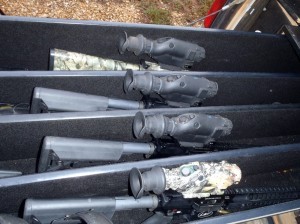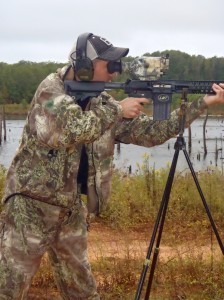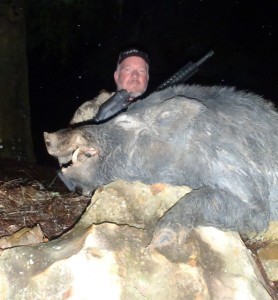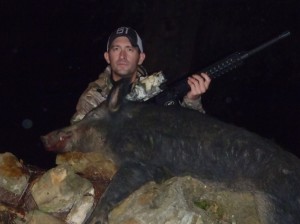Published: Oct. 14, 2011
With all due respect… RIP “Taz” DiGregorio.
“Think, ‘hog control,’ not hunting.”
That was the key message in the email sent out to our group by way of introduction from Rod Pinkston, CEO of JagerPro Hog Control Systems and, along with Winchester Ammunition, our host for two nights and days. JagerPro specializes in two things, nighttime hog depredation with advanced thermal imaging equipment, and hog trapping. We had been invited to experience a little bit of both.Our group consisted of myself, freelance writers MD and Julia Johnson, and Brian Lynn from Outdoor Life. Mike Stock, the Winchester marketing representative who put the whole shindig together, was along as well.
in the email sent out to our group by way of introduction from Rod Pinkston, CEO of JagerPro Hog Control Systems and, along with Winchester Ammunition, our host for two nights and days. JagerPro specializes in two things, nighttime hog depredation with advanced thermal imaging equipment, and hog trapping. We had been invited to experience a little bit of both.Our group consisted of myself, freelance writers MD and Julia Johnson, and Brian Lynn from Outdoor Life. Mike Stock, the Winchester marketing representative who put the whole shindig together, was along as well.
The plan for the visit was centered around two nights of depredation hunts with Pinkston’s thermal imaging scopes, mounted atop AR-platform .308 rifles from Lewis Machine and Tool (LMT). I’m still pretty new to the AR rifles, so I can’t offer a lot of explanation about what really sets these rifles apart from others in the genre, but I can say they’re a pretty cool piece of machine-work.
Ammunition for the hunt was provided by Winchester. We’d be trying out their new Razorback XT. The .308Win load is topped by a 150gr, lead-free bullet (gilding metal) that is specifically designed for delayed expansion so that the bullet can penetrate the thick, mud-caked hide and heavy cartilage of these tough beasts. The JagerPro guides questioned the choice of 150gr, but Mike was confident that the bullet would perform.
The proof would be in the pudding. All we needed to do was to find some hogs and put the bullets to work.
Jager Pro does their best work at night.
I sort of knew that going in, of course, but what I didn’t think about was that these guys aren’t hunting. This isn’t sport. This is eradication, and it’s business. To the farmers whose crops are being destroyed by the porcine raiders, it’s a matter of hundreds of thousands of dollars. To the guys at Jager Pro, it’s a matter of pride and a sense of responsibility to their customer. They don’t play in half-measures and they don’t work for half the night. This is a game of sunset to sunrise.
So I shouldn’t have bee n surprised that, after my arrival on Monday afternoon, there was no time for rest. We spent a little time sighting in the rifles, ran out to a local Mexican joint for dinner, and hit the field. Sleep would come later… much later.
n surprised that, after my arrival on Monday afternoon, there was no time for rest. We spent a little time sighting in the rifles, ran out to a local Mexican joint for dinner, and hit the field. Sleep would come later… much later.
Mike, Brian, and I hit the road with guide, Lance Hopper. MD and his wife, Julia would ride out to another location with guide, Chris Monhof. The guides had been scouting all day, and had a couple of prime properties to get started. Unfortunately, the weather-guesser had lied again, and the rain that was supposed to taper off by early evening only intensified. So had the wind.
By 22:00, the wind was driving the rain sideways across the peanut field. Lance had spotted a small group of hogs earlier, but the wind shifted and they took off before we could make a stalk. Once the weather turned harsh, we knew the odds of spotting more pigs were getting slim. We stuck it out anyway. The results were predictable.
At around 05:30, we rolled back into the lodge. The rain had turned into an old-fashioned downpour as we sipped “nightcaps” and recounted the fairly uneventful night. Exhausted, I was good for one drink and then turned in for the day. Sunrise was a hazy glow through the window when my head hit the pillow. I’d been going strong for well over 24 hours.
After a couple of hours sleep, I spent the afternoon riding with Rod. I’d asked him if he could show me some of his traps, and talk a little about trapping as a depredation method. He had a new design for traps and an approach to trapping that was producing some pretty amazing results. In some cases, he was able to catch the entire sounder of hogs. The majority of trappers are lucky to get a handful of juveniles, while the more mature and experienced hogs shun the traps.
We checked out a trapping site, and stopped off at the fabrication shop where they were assembling some trap parts based on his specifications. The parts weren’t ready yet, though, so I didn’t get to see them at work. I’ll have to catch up with that later, I suppose, but you can read about it on the JagerPro website if you’re interested.
Back at the lodge, we made it just in time to be served a phenomenal, down-home, Southern dinner. There was enough food for three times as many people, and it included chicken-fried steak, collard greens, black eyed peas, and corn bread. Dessert was apple cobbler and ice cream. With a belly full of all that, it was a surprise any of us could get away from the table. How we’d make it through another night in the field was a mystery to me.
We rolled back out as the sun was dipping behind the pines. We’d be working an 1800 acre farm that had been seeing a lot of hog activity. The plan for the evening was for Mike and myself to ride with Lance, while Brian would head out with Rod. MD and Julia were forced to pull out early due to unexpected circumstances. Chris had an errand to run, but would be back out to scout some sections that we couldn’t see.
The moon would be completely full, but the skies were still heavily overcast and spitting rain. The wind died out for the most part, though, and we were all pretty hopeful for a very eventful night. In my mind, I was imagining scenarios from some of the Jager Pro videos off of YouTube. We’d see groups of eight or ten animals and let the Razor Backs fly! In the morning light, we’d be posing with piles of dead peanut thieves.
If you want to limit your success on a hunt, invite a bunch of outdoor writers.
We’d set up on a high spot in the middle of a huge field. The evening turned into night, and still, we sat waiting. Every once in a while, Lance would get up and glass the field with the “heavy”, a large version of the thermal imaging scopes. Eventually we sort of started taking turns scanning the area.
I took my turn somewhere around 22:30. Have I mentioned how cool this thermal imaging stuff is? If you’ve never seen it, the scopes show images based on their heat signatures. The hotter an object is, the whiter it appears. The cool thing to me was that almost everything had some sort of heat coming from it, whether it was a longleaf pine or a sand road. All around the field edges, I could see the shining white bodies of dozens of deer. Some were feeding. Some were bedded in the peanuts. Some were just sort of meandering.
But none were hogs.
Then I spotted something different. It had the sort of distinct, rounded back profile that could be a hog, but it wouldn’t turn broadside so I could get a clear look. I got a little excited, and panned around for a moment to see what else was out there. When I came back around, it had moved a little. I still couldn’t tell, so I called Lance to take a look. It was a ‘possum.
Since he already had the scope in hand, Lance took a spin. I watched as he slowly scanned in 360 degrees, and then he stopped suddenly. His posture changed as he peered into the scope to verify what he saw. He lowered the scope and then raised it again. Then he turned to us. “I’ve got two hogs,” he said. “They’re probably 600 yards away, a long walk, but I think we can get to them.”
The stalk was on.
Stalking at night, under these conditions, is a really different experience. You follow single-file behind the guide, who is carrying the “heavy”. Since he has the spotter, he’s the only one who can see what you’re stalking. It’s a weird feeling, because for all we knew, we were just walking toward the darker line of trees on the horizon. The guide watches the hogs and their body language, stopping when they get alert, and then moving as they feed. When he stops, we stop. When he goes, we go. A few hundred yards like this seem like miles, and at every stop we cringe, waiting to hear that the hogs have winded us and left the field.
They didn’t leave the field, but Lance started getting nervous as we got closer. Despite the heavy cloud cover, the full moon was still lighting the place up pretty well. Out in the open as we were, we’d be somewhat backlighted. He finally called a halt, and signaled us to set up our shooting sticks. It was on.
I put my rifle up on the sticks, and struggled into position behind the scope. With these thermal scopes, the trick is to put your eye fully into the eye piece housing. This housing is pliable rubber, but putting my eye into it flies in the face of years of shooting with traditional scopes. Get too close, and you’re gonna get bit. Not so with these, but it took a conscious effort to stay in proper shooting position.
The next trick was identifying the target. At first, I couldn’t find it at all, and then the hog was just a glowing blob. It was only after my eye adjusted that I could recognize the profile. I couldn’t see the second hog at all, but my job was to shoot the one on the left. Mike would be responsible for the one on his side. Lance would shoot backup. You don’t want the hog to leave the field, if you can help it.
We were to shoot on a countdown from three. Lance started counting, and I took up the slack on the two-stage trigger. At one, I felt myself tensing, and when I should have pulled the trigger I jerked the whole rifle. Despite hearing Mike’s gun going off, I backed off and took a quick breath before bearing down on my hog again. It hadn’t quite realized what was happening yet, and I was able to send a round behind the shoulder. The hog dropped on impact.
I still heard shooting, so I scanned to see if the other hog was running into my field of fire. I couldn’t see it, but as I passed across my hog, I saw that the damned thing was back on its feet. I fired again, and realized that Lance was shooting too. I think my second shot was a miss, but on my third shot the hog rolled, feet in the air. I breathed a sigh of relief, but kept the scope on him.
Sure enough, the bloody thing was back up and pushing for the woodline. Lance was shooting, and I sent a couple more rounds at him. He seemed to drop, and then was up again. I lead him across the nose and sent one more. At that shot, the hog dropped out of sight.
“He’s down,” I heard Lance say. “But keep an eye on him.”
I stayed in the scope for a bit longer, until Lance finally said to put the rifles back on Safe.
“That was a little longer shot than we usually take,” he said. “But I thought we were gonna get busted any minute.”
Usually, the shots are inside of 100 yards. They’re often in the 60 to 70 yard range. Lance walked off the distance as we moved to check on our animals. We reached my hog at 215 paces. Mike’s hog had been about 30 yards or so to the right of mine, but there was no sign of it.
Because I thought we were so close, I’d imagined my hog would be in the neighborhood of 125 pounds or so. As it turns out, he was quite a bit larger. I’m still waiting on an official weight (Lance sent him whole to a taxidermist). No wonder he took so many hits from that .308 to bring down! I’m fairly certain that I hit him at least twice in the body, and Lance was pretty sure he’d made at least two hits as well. I think that my last shot went in just ahead of his eye and out through his nose. At any rate, someone’s shot did… either mine or Lance’s.
We tried to trail the other pig, but besides a set of running tracks in the muddy road, we found no sign of it. There was no blood, and the tracks appeared to be running normally (no dragging feet or stumbles), so we think he managed to escape unharmed. Either that, or he was simply bulletproof.
We loaded the boar and went back to our glassing point. There was a lot of night left, and the conditions seemed perfect. Nevertheless, we never saw another pig in our field.
Somewhere around 04:00, Mike decided we’d had enough. I couldn’t argue. We’d sit it out another half hour or so, and then pack it in. As we waited out the clock, a single shot came from the other field. A moment later, it was followed by one more. Then there was silence. Brian and Rod had just whacked a hog.
We g athered up the gear and headed out at 04:30. It was near 06:00 when we finally made it back to the lodge. We conducted a short photo session (thank goodness for auto-focus cameras, because I doubt any of us could see straight enough to focus manually). There was a lot of goofiness and laughter as we set the animals up for pictures, but we finally got it done.
athered up the gear and headed out at 04:30. It was near 06:00 when we finally made it back to the lodge. We conducted a short photo session (thank goodness for auto-focus cameras, because I doubt any of us could see straight enough to focus manually). There was a lot of goofiness and laughter as we set the animals up for pictures, but we finally got it done.
I wanted to do a post-mortem on the big boar, to see how many shots actually connected (we were pretty sure there were at least four in the body), and what these new Winchester bullets did. A boar like this would be a real test for any bullet. None of the shots had passed through, except for the shot through the nose. The mud-caked hide was enough to stop some bullets by itself, and I could only imagine at the thickness of the boar’s cartilage shield. I was eager to get the skin off and see what we could find. Lance wanted to get him to the taxidermist, though, and let the professional handle the caping. I was way too tired to argue, as he loaded the boar up and took off down the road.
Update: 10/14/2011 12:40 – Just got word from the taxidermist in Georgia. The boar weighed in at 276lbs, live weight.
The big hog had taken three hits to the body. Two had passed clean through, side-to-side. I still can’t believe we didn’t see any evidence of exit wounds, but it’s hard to describe how dense and mud-packed the hide was on this animal. A third shot had quartered in (probably while he was running away) and passed through the entire thoracic cavity to lodge in the off-side leg bone. The recovered bullet had expanded fully and still had all of the petals (no shearing, even when lodging in the large bone). That’s pretty good bullet performance. A fourth bullet had glanced off of the shoulder, and the fifth was the aforementioned shot through the nose.
Brian’s hog was not a tiny thing either. It was a good 140lb boar, and they’d hit it twice. The first shot, from about 83 yards, had gone in behind the last ribs and quartered forward into the animal. I opened up the skin and separated the off-side shoulder. After some dig ging, I found the spent bullet lodged in the boar’s shield. It had passed through about a foot and a half of hog, and mushroomed perfectly without losing any petals. That’s not too bad, although I was a little surprised that the lead-free bullet hadn’t completely blown through. Another testament to the toughness of hogs. The pig had been dying, but not dead. Brian’s second shot had gone into the head and exited, so I couldn’t check that bullet.
ging, I found the spent bullet lodged in the boar’s shield. It had passed through about a foot and a half of hog, and mushroomed perfectly without losing any petals. That’s not too bad, although I was a little surprised that the lead-free bullet hadn’t completely blown through. Another testament to the toughness of hogs. The pig had been dying, but not dead. Brian’s second shot had gone into the head and exited, so I couldn’t check that bullet.
All in all, the whole thing was a pretty extraordinary experience. Shooting hogs with thermal imaging optics definitely ranked high on the “cool” meter. Because of the way the whole thing played out, it wasn’t really all that different from spot and stalk in the daylight. We found the animals, moved on them, and made the shots. The fact that it took place at night certainly gave us some advantage, although I think an identical stalk could have been done with the sun up. Of course, had we come up on an entire sounder, the cover of night would certainly have been a necessity to get close enough for multiple kills.
I’d like to shoot a couple more hogs with the Razor Back XT ammo, before I make any huge pronouncements, but the fact is that both hogs we hit were very dead. The big one soaked up a lot of lead copper, but I’m pretty sure the first hit would have been fatal over a short time. There wasn’t much blood, but with a well-placed shot, you don’t need a lot of blood trail anyway.
I would be very interested in seeing a similar bullet for the 30-06 in 168 or 180 grains. I get the feeling that would be a hog-slaying combination! Mike said that more calibers would be on tap after the initial rollout. I’m looking forward to it!
I also saw the perfect use for the AR platform on this trip. When you need a lot of firepower, these rifles are designed to deliver it. The recoil is barely noticeable, and you can put a fair number of shots on target in a short amount of time. If you’re trying to take out as many animals as possible in a single engagement, this is definitely the way to go. And honestly, shooting these rifles is just kind of fun anyway.
Overall, it was a great trip and a learning experience. I’m really thankful to Winchester Ammunition for sponsoring this trip, and for allowing me to be part of the whole thing.
I’ve got some more to say about Jager Pro and what they’re doing in upcoming posts. I think I’ll be digging into trapping and depredation a little more in the near future as well, and Rod Pinkston and his guys are definitely in a league of their own. Stay tuned!









